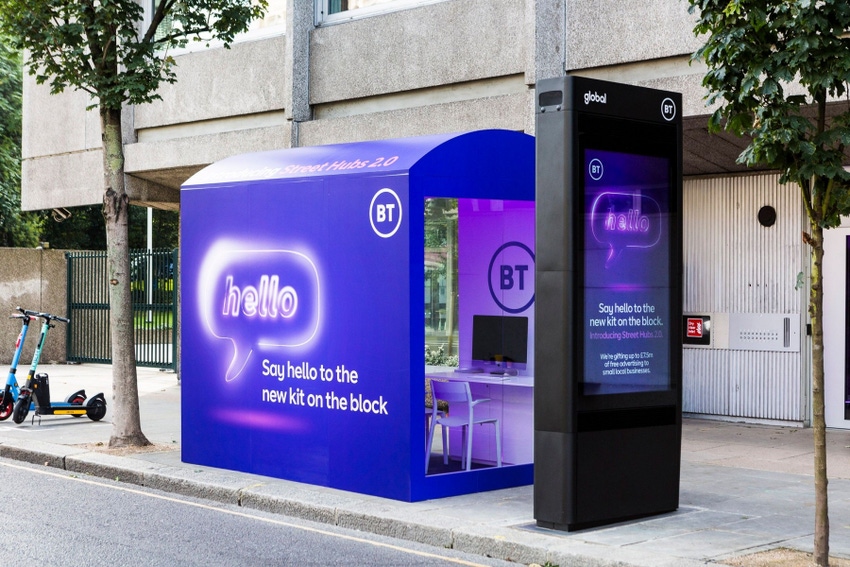BT pushes on with plan to disguise advertising as altruism
BT has switched on the first of its new generation of street hubs in London, which essentially offer free connectivity in exchange for advertising.
September 16, 2021

BT has switched on the first of its new generation of street hubs in London, which essentially offer free connectivity in exchange for advertising.
The first Street Hub 2.0 unit has gone live on Notting Hill Gate, in the London Borough of Kensington and Chelsea. It’s the first of a planned 300 such hubs scheduled to hit the streets in the UK over the next year, which will add to an existing 400 version one hubs already in situ. The street hub is essentially the 21st century’s answer to the phone box, incidentally.
BT has increased its rollout goal for the Street Hub 2.0 since it unveiled its plans just over three months ago. The UK incumbent unveiled the new hubs in June and said it would deploy 200-plus units, subject to obtaining planning permissions.
But the number of hubs arriving on the UK streets is not the only to have changed over the summer. The messaging around them has shifted too.
Street Hub 2.0 “introduces upgraded features such as sustainable design, environment monitoring for local authorities and the ability to boost 4G/5G mobile coverage,” BT said back in June.
“Reflecting BT’s purpose to connect for good, more than 400 Street Hub units are already delivering a wide range of economic, social and technology benefits to communities and local councils up and down the country – from connecting local residents, businesses and visitors to free ultrafast wifi, to ensuring that people can contact the emergency services or charity helplines in times of need,” it said.
All very worthy. Of course, we knew back then that the units would be funded through advertising, just as the first lot of street hubs are. The fact that the unit itself is essentially one giant screen is also a giveaway. BT said it would use a new hardware partner in Trueform Digital to provide the units, as well as continuing to work with digital signage solutions specialist ADXBA and its advertising partner Global.
But BT’s focus was very much on the societal benefits of the new hubs. It talked up their CO2 sensors, the free wifi, the 4G and 5G small cells – the wording was careful here; the units can incorporate small cells, BT said, not will – and the fact that the advertising capabilities could help rejuvenate the high street, post-pandemic.
Fast-forward quarter of a year, the first unit is in place, and it’s all about the advertising.
BT marked the launch with the announcement that it is giving away up to £7.5 million worth of advertising space on the hubs to small businesses – it will be looking for nominations for worthy recipients in the coming weeks – and that it has co-located the first unit with what it terms a pop-up design hub, whose aim appears to be to advertise advertising. Specifically, the design hub “showcases the power of digital street advertising for small firms looking to boost awareness of their business following the pandemic,” BT said.
Naturally, it has data to share. A new BT study shows that more than 60% of small businesses agree that local advertising would help increase awareness of their business, while 40% say it would encourage more people to shop at their local high street, but 49% see cost as a major obstacle to them doing so. That’s where BT’s giveaway comes in.
“We hope that, by gifting free digital advertising space via our new Street Hub units, we can give small businesses an extra boost as high streets spring back to life,” said James Browne, head of BT’s Street business. “Our new Street Hub units can play a vital role in helping small firms to bounce back – whether that’s through building greater awareness of their business through free advertising, or by rejuvenating the high street by boosting local digital infrastructure.”
There’s no doubt the high street needs a shot in the arm. Where once the debate was around whether a proliferation of advertising screens constituted a blot on the landscape of the local high street, we are now looking at a world where most shopping is done online and brightly-coloured ad screens could effectively constitute the local high street. Why not pop out to browse the ‘to let’ signs in the windows and snag some free wifi…in exchange for being the target of an ad campaign.
About the Author(s)
You May Also Like








.png?width=300&auto=webp&quality=80&disable=upscale)


_1.jpg?width=300&auto=webp&quality=80&disable=upscale)


.png?width=800&auto=webp&quality=80&disable=upscale)